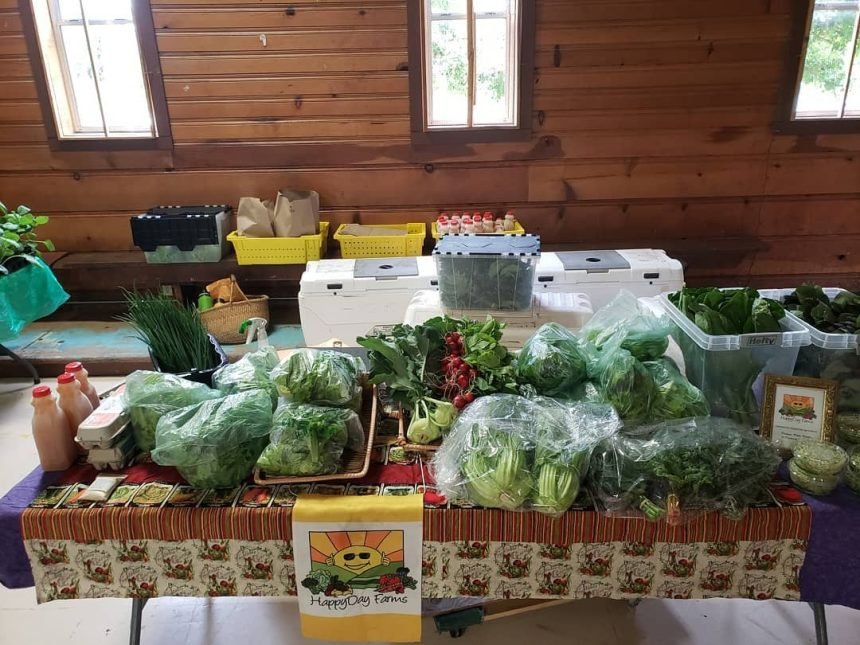Casey O’Neill is a farmer and owner of Happy Day Farms in Laytonville, Calif. The opinions expressed in this column are not those expressed by The Mendocino Voice.
I’m thinking about mutual aid networks, ways of sharing resources to make sure that there is enough food to go around. It’s a hard realization to come up against just how little I’m capable of producing in the scope of a community’s needs, but it’s heartening to see us pull together. The donation table at the market last week was awesome, big thanks to everyone who brought food to share. We’ll be stocking it again with cooking greens and potatoes this week.
The thing about SNAP is that even when the benefits are being released, they are not enough. SNAP should be expanded, not contracted, especially with the changes in the economy, the rise of AI and the continued increase of billionaires stealing the productivity of workers while wages remain stagnant. That said, I am glad that benefits have been released, but we’ll still be focusing on gathering donations for the market and for the Laytonville Food Bank on the third Friday of the month, the 21st of November.
It all has me thinking about local food security, about how hard it is to trust government systems when they can be manipulated by the wealthy to deny support to folks in need. I’m grateful for the hard work of the people who make the food banks happen, and for all the community members working to support each other through donations and sharing of resources.
Community free-food pantries like the one on Branscomb are a critical part of food-sharing that operate as mutual aid networks for folks in need. Low-cost sharing that makes food accessible when it’s needed has to be a core part of the strategy for making sure that everyone in our community can eat. The more we share what we can, the stronger we are together. When we feel the caring of our neighbors it changes how we feel about our little place in the world for the better.
Sharing what we can is a critical step towards meeting immediate needs, but in the long term we have to increase the amount of food we grow in our communities. We need more gardens, more livestock, more people involved in the care of plants and animals. As macro systems become more variable and untrustworthy with the breakdowns of late-stage capitalism, we will need to be able to do more for ourselves.
Laytonville is an agricultural community that has suffered through the crash of its main export crop. The infrastructure is still in place; pivoting to food production is not easy, nor will it bring in the type of money that cannabis used to, but it has to be part of our strategy of community survival. The quality and freshness of food grown locally has much to offer, and shared sales channels like consignment farmstands, farmers markets and food bank donations do a great job of sharing the surplus around and generating some income.
On the farm I’m focusing on late season planting and moving into some light infrastructure upgrades. Because our whole farm is on a slope, all of our beds are terraced, and I’ve been gathering used metal roofing, T-posts and foundation stakes to shore up terrace banks and create more effective growing space. As is, I lose the outer edge of the bed on the low side as a planting space for the quick rotation crops because it always wants to slump downhill. With a hard panel wall, I can plant right out to the edge and deal less with erosion.
I’m halfway through planting the current wave of greens, with the next one about ten days out from being ready. This week we’ll sow another round of seeds to keep the pipeline topped up as we edge towards the end of the year. Growth has slowed, but things are still ticking along, and the crops that were planted out earlier in the fall are coming into abundance. Last week saw the first of the broccoli for CSA and the first heads of cabbage for the market table and a new batch of sauerkraut.
I’m glad for a few days of sun after the big rains last week, giving me some time for projects, planting, and working with the livestock. Yesterday we moved all the sows and piglets to the north pasture and expanded their range with the electrified pig netting. Then we put the sheep in the south pasture where the forage provides abundant grazing. I moved the chickens to fresh ground after spreading the manure and straw from the coop on the area they had scratched up, and I’m looking forward to the flush of growth that will happen there in the weeks to come. Animal rotations are like anything else in farming; they take time and effort, there are often mistakes, but over time it gets better and better. As always, much love and great success to you on your journey!
Casey O’Neill owns and runs HappyDay Farms, a small vegetable and cannabis farm north of Laytonville. He is a long time cannabis policy advocate, and was born and raised in the Bell Springs area. The preceding has been an editorial column. The Mendocino Voice has not necessarily fact-checked or copyedited this work, and it should be interpreted as the words of the author, not necessarily reflecting the opinions of The Mendocino Voice.











